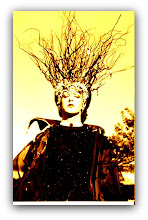The Bible, fairy-tales and myths are linked by their remarkable narrative stability--- yet their simplistic and often charming form hides their raging misogyny. These cartoonish and often distorted images of women permeate much of modern culture: the raging she-devil, the madwoman, the slut, the gorgon, the temptress.
Anthologies by women writers who attempt to revision these stereotypes are few and far between.
What if the considerable wattage that myth can bring to the narrative is maintained, but these bad girls now exhibit beauty, grace, intelligence, sexiness, creativity? Or at the very least, tell their side of the story?
Perhaps there should be two or three variations on a deeply embedded story, not a single, monolithic one.
Perhaps its time to burnish the rotten reputation of some of the most devilish, the most evil, yet inherently the most powerful women in myth and literature. How would we view Pandora, Delilah and even Grendel through another lens?
Tales from the Velvet Chamber would attempt to answer these questions. In stories that would be dark, funny, sexy and
unexpected.





